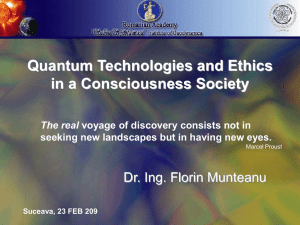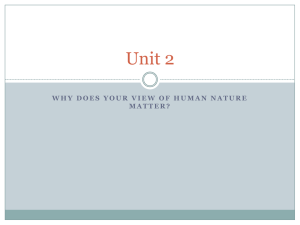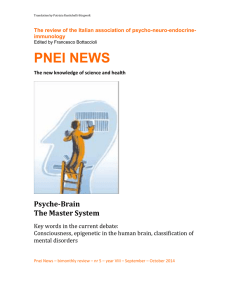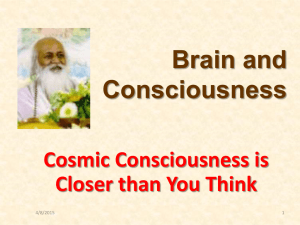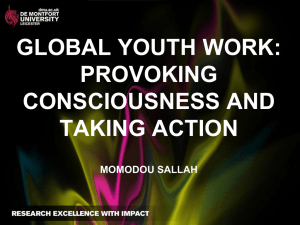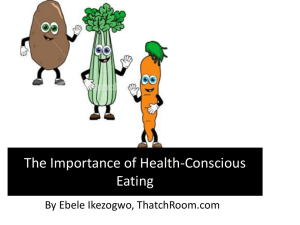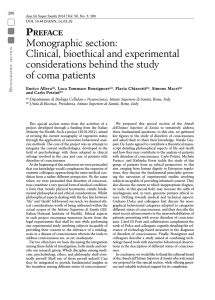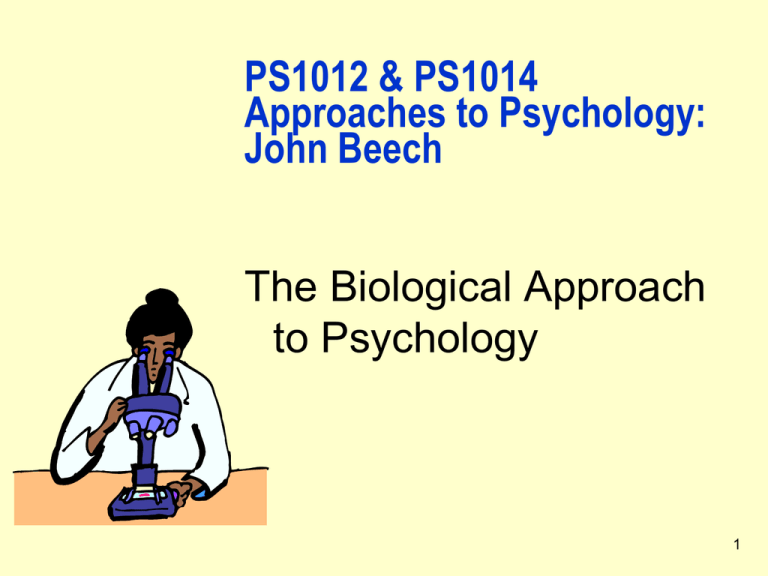
PS1012 & PS1014
Approaches to Psychology:
John Beech
The Biological Approach
to Psychology
1
The Biological Approach
1. General introduction
2. The history of the biological approach
3. Different aspects of consciousness:
(a)
A case study
(b)
Blindsight
(c)
Split-brain experiments
(d)
Animal consciousness
4. The mind-body problem and Greenfield’s solution
(a)
The properties of consciousness
(b)
Can we find these properties in the brain?
(c)
States of consciousness
2
1. Introduction to the
Biological Approach
This approach views humans as a biological organism.
Thought processes are based ultimately on changes
within our own physical selves, our biological
structures.
The main concerns of this approach are:
(1) the relationship between mind and body
(2) the influence of heredity on behaviour and to a
lesser extent
(3) the effects of the mind on the body.
3
2. The history of the
Biological Approach
Concentrating on the first of these: the relationships
between mind and body
More specifically, we are going to examine the different
faces of consciousness in relation to its biological basis.
But first, some history…
Today’s biological approach is: we have a brain that
determines our behaviour. The 17th century view was
the Christian view: the body was controlled by the soul
or spirit.
Rene Descartes:
Human body was similar in construction to any animal.
Animals and humans operated like machines. But
4
human beings had souls.
2. The history of the
Biological Approach
This soul interacted with the pineal gland.
Known as dualism. Body and mind (or soul)
are separate, but they interact. l’âme can
mean “mind” or “soul”. This view prevailed
200 years after this.
Gradual shift of biologists away from
dualism to monism: the mind and the body
are the one thing. Very close to that is
materialism: all behaviour has a
physiological basis.
5
2. The history of the
Biological Approach
One problem with dualism is if the
mind is abstract and non-physical,
how can it exert control over
something physical like the body?
But monism, like dualism, is still an
assumption. Materialism, which is
basic to the biological approach, is
becoming more influential in
psychology.
6
2. The history of the
Biological Approach
Julien de La Mettrie (1745): the body
is a machine and the mind is part of
the body. He’d had a fever and
noticed that it had physical and mental
effects. This led to his materialist
assertions. Very controversial.
Cabanis argued that the victims of the
guillotine were not conscious after
being beheaded as their consciousness
was within the brain.
7
2. The history of the
Biological Approach
Paul Broca (1861) examined a man unable
to talk coherently because of head injury.
When he died Broca showed by post-mortem
that specific area in the brain damaged. This
was proof of “localisation of function”.
Role of hereditary - important aspect of
developments in biology. Shows how our
characteristics are transferred from one
generation to the next. In the 18th century it
was believed that as described in the Bible,
all species had been created independently.
8
2. The history of the
Biological Approach
Linnaeus (1735) catalogued 4,000
plant and animal species and proposed
connections among species.
Charles Darwin (1859) “On the
Origin of the Species”
9
2. The history of
the Biological
Approach: Darwin
By chance there would be variations across
individuals and they could be passed on
genetically.
“Natural selection” proposed that if a
particular alteration in a gene helped people
to live and breed, then the gene was passed
on.
Darwin was not only referring to what is
inherited across humans, but the evolutionary
links between humans and other animal
species. Led to a row with the church.
Eventually Darwin’s view of evolution
became dominant.
10
2. The history of the
Biological Approach :
Conclusion
The concepts of materialism and
heredity are the basis of the biological
approach to psychology.
Materialism is saying that the mind
has a basis in terms of the physiology
of the body.
Heredity is asserting that aspects of
behaviour are inherited from ones
parents.
11
2. The history of the
Biological Approach:
Conclusion
In contrast to other approaches to psychology,
biology is saying that it is very important not to
speculate about the mechanisms inside the black
box. Instead we need to examine within.
The internal structure of the body (and especially
the brain) needs to be taken into account.
An early example: if a specific area of the brain
were destroyed it would severely damage speech
Similarly, Darwin tried to demonstrate that aspects
of our behaviour are partly due to inheritance. 12
3. Different aspects of
consciousness
Not all areas of
the brain
involve
consciousness;
e.g. the
cerebellum
controls
balance and
reflexes and is
automatic.
13
3. Different aspects of
consciousness
We can be unconscious of events (e.g.
Goldiamond, 1965).
He gave electric shock to S reading aloud until he
stuttered. Produced stuttering.
Still in same paradigm, 2 days later he was only
shocked twice. But he was unaware why
stuttering had been induced.
Areas of the brain proposed for the seat of
consciousness in the past have included: the
hippocampus (O'Keefe, 1985); activity from the
upper brain stem (Penfield, 1940s and 1950s)
and the cerebral cortex (large number of
investigators).
14
Some neurological
evidence to
consider:
(a) Case study:
trapped in the
60s
Oliver Sacks
(1995) studied
Greg in the
1990s.
Treatment for a
tumour was
delayed. Greg’s
pituitary
(shown later)
and optic
chiasma were
destroyed.
3. Different aspects of consciousness: (a) a
case study
There was damage to frontal and
temporal lobes leaving him
blind and mentally damaged.
He sat motionless and silent,
but if asked something
responded immediately. He
also had 'blindness denial'. He
‘watched’ TV, by just
listening to the sound track
and inventing images. They’d
tried to teach him Braille, but
were unsuccessful.
15
3. Different aspects of
consciousness: (a) a case
study
In the MRI above TP is the
“temporal pole” – the front of
the temporal lobe. In the
inner surface of the temporal
lobe is the hippocampus
outlined in white and marked
HIP. AMG is the amygdala.
Greg believed that he was in the
1960s. Hippocampal damage
led to a gradient of damage to
long-term memory. He was
unable to remember
information for very long. If
‘shown’ an object he would
guess its identity. He seemed
to have no sense of time,
especially as he had no recent
experiences to draw upon.
This meant that the present
was just flat.
16
3. Different aspects of consciousness: (a) a case study
He had an implicit,
or unconscious
memory. Learned
spatial layout of
the hospital and
learned about the
personalities of
the staff.
The pituitary
damage reduced
his hormonal
aggressiveness.
Previously he'd
been aggressive
with his father.
The diencephalon
controls drives 17
(e.g. food, sex).
3. Different aspects of consciousness: (a) a case study
If no stimulation, he went into a
daze. Sachs suggests that this
state was devoid of normal
thought or emotion. Taken out
of this state, his behaviour was
animated, perhaps inappropriate.
This could be connected with
frontal lobe damage.
These areas involve making
judgements and planning. This
changed his voice and manner.
He had the 'joking disease'. The
frontal lobes more developed in
humans than primates. They do
not stop until age of 7. They
could be important for
consciousness.
18
3. Different aspects of consciousness: a
case study: Greg and some aspects
Normal memory
Emotions
STM
STM
LTM
LTM
Vocabulary expands in LTM. It helps us to
socialise. It’s part of personality.
Our emotions are part of
our personality. If we
have no emotion, are
we human?
The visual system
Perception
Imagination
These two systems are not normally
confused.
19
3. Different aspects of
consciousness: (b) blind sight
Due to damage to part of
visual cortex (or occipital
lobe). Retina still picking
up information. But will not
be 'seen'. If moved to other
parts of visual field not
damaged, then will be seen.
DB had part of visual cortex
removed, seen by
Weiskrantz (1987). He
placed stimulus in DB’s
blind field and asked him to
guess what it was.
20
3. Different aspects of
consciousness: (b) blind sight
DB had 100%
accuracy, even though
he said that he could
not see it. However,
the lower temporal
lobe is also processing
information from the
retina.
After training DB
developed awareness of
items in his blind field.
21
3. Different
aspects of
consciousness
(c) split-brain
Corpus callosum
completely
severed so left
and right
cerebral
hemispheres
can no longer
communicate
with each other.
22
3. Different aspects of
consciousness: (c) split-brain
Sperry (1966) and others
studying split-brain patients
have demonstrated that the
right hemisphere can
perform spatial thought,
musical perception,
understand simple nouns
and do simple arithmetic.
The left hemisphere
generally is able to control
the output of speech.
23
3. Different
aspects of
consciousn
ess: splitbrain
24
3. Different aspects of
consciousness: (c) split-brain
Wilson et al. (1977) examined PS. After
operation only left could speak, but later the
right learned to speak as well! Appeared that
both sides conscious and independent and
even had different preferences. Possibly
other right hemispheres are conscious as well
in other split-brain patients.
Perhaps those of us learning to type, play the
piano, or do some task involving the two
hands, and hence the left and right
hemispheres, have also experienced how our
different hemisphere learn to handle new
information.
25
3. Different aspects of
consciousness: (d) animals
Some say that animals cannot verbalise,
therefore they have no consciousness. But
verbalisation is clearly not the only route.
We can think spatially, visually, musically
and imagine in smell and taste and so on.
Some have said that that right hemisphere
has the same level of consciousness of a
chimpanzee, due to being unable to verbalise.
26
3. Different aspects of
consciousness: (d) animals
Chimpanzees and gorillas are able to
sign. But this is dismissed by some.
Dogs appear to dream.
Dolphins have a large complex cortex
and send complex sounds to each
other.
An octopus appears to be quite
sophisticated.
27
3. Different aspects of
consciousness: (d) animals
We can go down the phylogenic scale to the level
of insects. The behaviour of the digger wasp
appears to be mentalistic.
But a simple experiment shows a great reluctance
to adapt to a new situation. Experimenter removes
prey while wasp inspects cavity. Each time it
searches and brings it back to hole. Eventually it
realises that it should not let go and instead should
simply put the prey straight into the hole. But it
can take 30 to 40 trials to learn this simple change.
Thus animals can appear to be irrational as we
move down the scale. There can be a strong
element of mechanistic behaviour rather than
mentalistic behaviour.
28
4. The mind-body problem and
Greenfield’s solution (a) The
properties of consciousness
(a)
(b)
(c)
We’ve examined the background to the consciousness
problem. There appear to be different levels of
consciousness within humans and in animals. This
consciousness can appear in many areas of functioning,
such as in vision and language.
There have been many scientific findings that can
be publicly examined; but the relationship of
consciousness with the brain is different. See Gross for
supplementary discussion of the mind-body problem.
We will examine the detailed arguments of Susan
Greenfield (1995):
The properties of consiousness
Can we find these properties in the brain?
States of consciousness
29
4. The mind-body problem and
Greenfield’s solution (a) The
properties of consciousness
She asks: what are the relevant aspects of the brain?
First, there is localisation of function and there is
parallel processing. Brain mapping, for instance,
shows that verbs processed in one part of the brain,
but other parts of speech elsewhere. Thus language is
not a unitary function, different parts have different
functions.
Thus no one area generates consciousness. But
consciousness seems to be a unitary experience.
What are the properties of consciousness?
30
4. The mind-body problem and
Greenfield’s solution (a) The
properties of consciousness
The source of consciousness is probably
distributed in the brain, but our experience is
of a unitary phenomenon.
It is continuously variable. Like dimmer
switch. This provides a view of human
development and animal consciousness. Also
individuals fluctuate in their level of
consciousness. Sometimes acutely aware of
the world, other times one is aware of an inner
world.
Consciousness derives from specific stimulus.
Analogy of fish jumping around in pond. An
epicentre sets a trend of consciousness.
31
4. The mind-body problem and
Greenfield’s solution (a) The
properties of consciousness
Summary: ‘Consciousness is spatially
distributed but effectively single at any one
time’. It emerges because of the continuous
activity of groups of neurones in relation to an
epicentre. This is analogous to an orchestra,
in that the symphony is only created when the
instruments are in unison.
32
4. The mind-body problem and
Greenfield’s solution
(b) Can we find these properties
in the brain?
There are millions of neurones in
the brain (32 million years to count
at rate of 1/sec).
Neuronal density increases as we
develop. Neurones also develop
according to the stimulation that
they have had.
The epicentre would be an inner
centre of neurones. Activation is
through one of the neurotransmitters
such as acetylcholine (ACh).
33
4. The mind-body problem
and Greenfield’s solution
(b) Are these properties in the
brain?
Libet et al. (1979) placed
electrodes on points in the
somatosensory cortex (deals with touch receptors
such as heat, pressure,
vibration, limb position,
movement, pain). Felt like
being touched. Had to be
more than ½ sec. Again, if
presented stimulus to skin,
took ½ sec before aware.
But brain would have
received this much faster.
Participants claimed that
immediately aware, despite
the long delay.
34
4. The mind-body problem and Greenfield’s
solution (b) Can we find these properties in
the brain?
Libet et al worked out location in the
somatosensory cortex corresponding to
Libet et al. (1979)
a point of sensation on the skin.
Touch Electric Result
Stimuln. Touch not felt.
0
Touch
0
Then Libet et al. touched skin here
AND electrically stimulated
somatosensory cortex.
When interval between being touched
and then being electrically stimulated
was less than ½ sec, then touching not
Electric Result
Stimuln. Touch felt. felt. Touching had been masked by
electrical stimulation. Thus conscious
experience is occurring ½ sec after the
event. It takes some time to get events
500msec
working from the epicentre before it is
35
finally perceived.
500msec
4. The mind-body problem & Greenfield’s
solution (b) Are these properties in the brain?
Arousal may be a factor.
When arousal low, few
connections begin. The
Yerkes-Dodson law: an
optimum level of arousal will
result in the best level of
performance, Acetylcholine
(ACh) could be the producer
of low arousal, whereas
dopamine and noradrenaline
(DA/NA) would be high
activators.
36
4. The mind-body problem and
Greenfield’s solution
(c) States of consciousness
Greenfield proposes 4 different types
of consciousness: dreaming,
distracted, thinking and being bored.
'Distracted' means like being a child
reacting constantly to its environment.
Thinking would be engrossing and
bored would be when waiting and
having little to do. Let us look at just
two of these states:
37
4. The mind-body problem and
Greenfield’s solution
(c) States of consciousness
Dreaming: this involves rapid eye-movements
(REMs) and is a form of consciousness. Brain
patterns of wakefulness and dreaming similar. But
logic is poor during REM. Consciousness is too frail.
Commonality between dreaming and schitzophrenia.
During dreaming ACh is low and strength of epicentre
is low. Means that only small neuronal assembly
activated.
REM sleep of foetus is 24 hours a day at one point, but
REM declines throughout the life span.
Penfield: stimulating same place twice got different
responses. He was creating different epicentres
according to the arousal level current at the time.
Sometimes he got the same response stimulating
38
different areas.
4. The mind-body problem and
Greenfield’s solution
(c) States of consciousness
The distracted state of
consciousness: Here there is high
arousal with high rates of dopamine
and noradrenaline (DA/NA). Strength
of the epicentre is high but the
neuronal assembly is small. This
activation of a small network soon dies
away.
39
4. The mind-body problem and
Greenfield’s solution
(c) States of consciousness
Greenfield would group together dreaming,
schizophrenia and childhood as they all
involve only a small activation of neural
assemblies.
The experience of an accident could be a
case of time standing still and over-arousal
(Yerkes-Dodson), so recruitment is again
modest.
40
4. The mind-body problem and
Greenfield’s solution
(c) States of consciousness
Going to a 'rave' with the drug ecstasy
may also lead to low recruitment.
Here there is a preference for music
with minimal cognitive involvement.
She concludes: consciousness will
never be explained by neuroscience,
but should come close to describing it.
In the future networks need to be
studied in real time.
41
The biological approach: in a
nutshell
1. General introduction
2. The history of the biological approach
3. Different aspects of consciousness:
(a)
A case study
(b)
Blindsight
(c)
Split-brain experiments
(d)
Animal consciousness
4. The mind-body problem and
Greenfield’s solution
(a)
The properties of consciousness
(b)
Can we find these properties in
the brain?
(c)
States of consciousness
42
The biological approach: in a
nutshell
(1) The biological approach views humans
as biological organisms. Our thought
processes come from our own biological
structures.
(2) Gradual shift from the dualist, Christian
view that the body and soul are distinct
entities that interact with one another. This
was replaced by the modern concept of
materialism in which the basis of all
behaviour is its underlying physiology.
43
The biological approach: in a
nutshell
(3) The case of Greg is interesting as a
description of a degraded form of consciousness
based on neurological damage. For instance, his
consciousness was entirely within the time era of
the 1960s with no new information coming in.
Also, he was unaware of his own blindness.
Furthermore, he appeared to be lacking in
emotions.
(4) Blindsight: patients reported not being able to
see an object, but on the other hand they “knew”
the identity of the object. We generally associate
the visual cortex with the consciousness of an
object, but there are other areas that also function
in this way, such as the lower temporal lobe.
Patients need training to develop awareness in
44
such an area.
The biological approach: in a
nutshell
(5) Split-brain patients are patients who have
separately functioning cerebral hemispheres
without the benefit of the connecting tissues of the
corpus collosum. Can lead to the development of
two independently operating systems, each with a
separate consciousness. Generally only one has
developed speech, but in one case (Wilson et al,
1977) it appears that both hemispheres have
speech.
(6) Animal consciousness: Can we infer that
because animals can’t verbalise that they do not
have consciousness? Nowadays animal
psychologists use mentalistic models to account
for animal behaviour. However, at the other end
of the phylogenic scale, for instance at the level of
the insect, behaviour is mechanical in origin. 45
The biological approach: in a
nutshell
(7) Greenfield’s theory of consciousness:
Consciousness is probably spatially
distributed across different parts of the
brain during different types of operation
ranging from language to music.
Consciousness is probably continuously
variable, for instance, as we have grown
from the foetal stage, our degree of
consciousness has probably increased.
In other species the degree of
consciousness is different, but
nevertheless at some level.
46
The biological approach: in a
nutshell
Greenfield has described a neurological
model of consciousness. E.g. a stimulus
immediately evokes a small epicentre of
neurons. Subsequent activation will be
influenced by the presence of
neurotransmitters.
If there is an optimum level of arousal
then the activation across the network of
neurons in all directions will be
corresponding greater, and the number
of neurons involved will be greater.
47
The biological approach: in a
nutshell
Different states of consciousness such as
thinking versus dreaming can be accounted
for according to variations in such things as
the type of neurotransmitter that is dominant,
the arousal of the network and the density of
the neural structure.
This neurological model helps us understand
the interplay between the mind and the brain.
48

